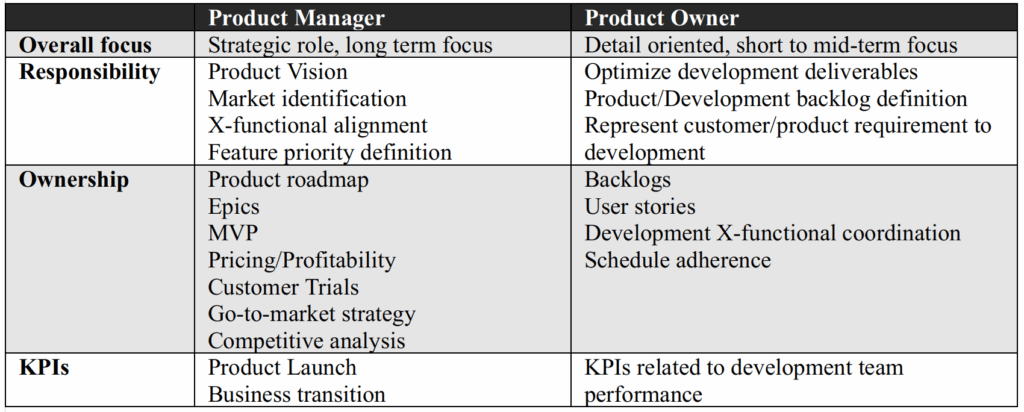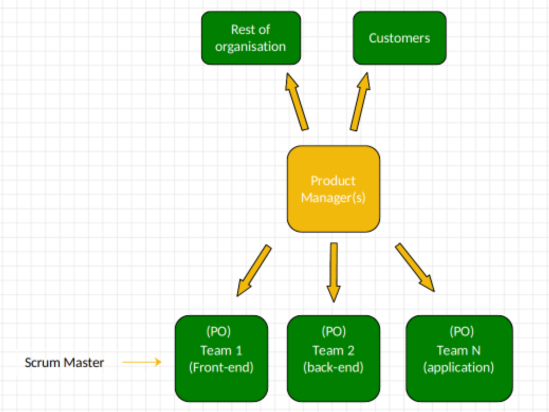– What’s the difference?
Introduction
After more than 20 years working with Product Management in one form or the other, I have lived through the change from the older development processes (“waterfall”) to the later (“agile”), feeling this has been a change for the better. However, I never really found out the details of Scrum/Agile, just using the methods the way it was defined at the company I worked, and how the tool we used (Jira) defined it.
Recently I took some Scrum and Agile courses, and I was surprised at how they descibe the role Product Owner. So I searched the web for more information and discovered for instance that Scrum/Agile mostly leaves out the role/function of the Product Manager and replaces it with Product Owner, and that job postings many times regard them as the same.
However, I think they are different, even though both are needed.
I will explain why below, beginning with some background information.
Agile
When you say “Agile” you really are referring to the Agile manifesto (https://agilemanifesto.org/).
As they define it, it is a “mindset not a method”. It was initially quite dogmatic, but has evolved to be less rigid than before.
Some of the Principles behind the Agile Manifesto (full list here: https://agilemanifesto.org/principles.html)
- Individuals and interactions over processes and tools
- Working software over comprehensive documentation
- Customer collaboration over contract negotiation
- Responding to change over following a plan
I fully agree to these, having worked with the opposite, seeing projects fail miserably.
Individuals, and their skills and experiences are more important than the org-charts and 100-page processes etc. I’ve been through management driven re-organization targeting improved productivity, but they accomplish nothing but confusion.
Short, incremental bursts. Don’t bite off more than you can chew.
Prove functionality ASAP. Always test/prove that the product/functionality can do what is expected, as soon as you can. Don’t wait until the end. Remember to test and prove non-functional requirements such as performance early (You remembered those, right?)
Accept delays – You should try to fix them or work around them, but don’t believe in last minute development miracles.
One more obvious remark. Always include a healthy dose of testing at the end of a project, even if you have tested as defined above. (meaning, don’t claim the product is ready just because coding is done)
Scrum
Scrum is an agile methodology and one of the most widely used project management methodologies in action today. It typically breaks projects down into sizable chunks called “sprints”. One tool that is often used is Jira.
It has some roles defined, incl. the Scrum Master and Product Owner, but they are actually optional. In my experience, there is no need for a dedicated scrum master. This can be filled by a common scrum master for all teams, or by the Product Owner.
In Agile, all devs are supposed to share tasks equally, which is good since it spreads knowledge and experience within the team. However, some devs, maybe the more experienced, must also take on a lead/architect role.
Scaling up Scrum
When you look into alternatives or expansions to Scrum, you find more the deeper you dig, it gets kind of confusing at the end. Here are at least two alternatives for scaling up Scrum:
Scrum@scale: https://www.atlassian.com/agile/agile-at-scale/scrum-at-scale
While scrum provides a framework for developing, delivering, and sustaining complex products by a single team, Scrum@Scale (S@S) focuses on the entire ecosystem of teams in order to transform overall organizational culture.
S@S has a role – “Chief Product Owner” that can be likened to a Product Manager.
SAFe: https://scaledagileframework.com/
Scrum is a small framework that guides how an inspection can be carried out quickly and adapted in a small space. SAFe® provides clear-cut processes and roles so that various Agile teams can work together as one big team in an Agile Release Train (ART).
Scrum Product Owner
Here is the definition from https://www.scrum.org/resources/what-product-owner
- Maximizing the value of the product resulting from the work of the Scrum Team
- Effective Backlog Management, including
- Developing and explicitly communicating the Product Goal
- Creating and clearly communicating Product Backlog items
- Ordering Product Backlog items
- Ensuring that the Product Backlog is transparent, visible and understood.
This is clear and understood, but they then list these responsibilities as well:
The Product Owner owns the product vision. Tasks include:
- Manage the product lifecycle and its long-term business objectives.
- Market research and competitive analysis; product strategy.
- Product roadmapping.
- Acting as the voice of the customer.
- Engaging with stakeholders.
- Maximizing revenue and return on investment.
- Product launch and product retirement.
To me, this sounds very much like the definition of Product Manager. If this is true, you don’t need Product Management. I’m not alone in thinking this. Example:
https://www.linkedin.com/pulse/what-difference-between-product-manager-pm-owner-po-jaimin-pancholi

As noted by Douglas L. Ringer, “A product owner will help you build a new product, but if you’re focused on building a business around that product, you need a product manager”. (toptal.com, 2022)
In many cases, employers see them as the same. Below are examples from real job postings. As you can see, the roles are described in similar fashion.
Product Owner job posting
- Engage collaboratively with stakeholders to craft a product vision for our customer experience.
- Contribute to the creation and upkeep of a roadmap that aligns with business objectives and customer needs.
- Advocate for user-centric design in partnership with the UX/UI team to ensure compelling customer interactions.
- Cultivate cross-functional teamwork across development, business units, and customer support.
- Gather and prioritize comprehensive product requirements, taking on the role of epic owner.
- Lead agile development processes effectively.
- Track KPIs meticulously to evaluate product performance and guide data-driven strategies.
- Solicit and integrate customer feedback to continually refine the digital experience.
- Stay updated on industry trends and competitor advancements.
Product Manager job posting
- Identify, prioritize, develop, and launch product initiatives in partnership with the CPO
- Work closely with a cross-functional team of engineers, designers, and data scientists to build and ship excellent product
- Work closely with our customers to understand their needs
- Execute product, market, and customer research to understand our space
- Communicate product plans, context and results to your teams and the rest of the organization
- Follow up on and evaluate releases
- Work passionately to ensure you and the team are focusing on the right things, balancing short versus long-term needs, and confidently navigating trade-offs
Conclusion
The difference between Scrum/Agile Product Owner and Product Manager is very fuzzy. As some see it (scrum.org), PO’s are supposed to take on all or most responsibilities of a PM, besides the work in the Scrum team.
As I see it, the responsibilities for the Product Owner should really be focusing on:
- Breaking product management’s epics into user stories.
- Arranging and prioritizing sprints.
- Evaluating progress at each stage of development.
- Answering dev questions about the reasoning for user stories or tasks.
The “customer” as defined in Agile/Scrum should be internal, e.g. the Product Manager(s)
A typical organization would then work like this:

The Product Manager then takes on more high level tasks, such as developing a product strategy, defining requirements, connecting with customers and collaborating with other departments across the business.
finally:
The Agile/Scrum/Product Owner way of developing products only works under some ideal circumstances:
- Smaller, isolated project
- Only one team
- Maintaining an existing product
Even though there are some “scaled up” Scrum variants, they still don’t take Product Management tasks into account, or expect each Product Owner to perform these. This is an incomplete model.
Examples where it will not work well without Product Management
- New product/platform
- Bigger, complex systems
- Multiple development teams
- Demanding customers
- That many organization (incl. Scrum.org) don’t understand the difference between PM and PO role.
So I say, there must always be some “Product Management” function, whatever you want to call it.
What is Good Product Management then? This will be the subject for my next piece……